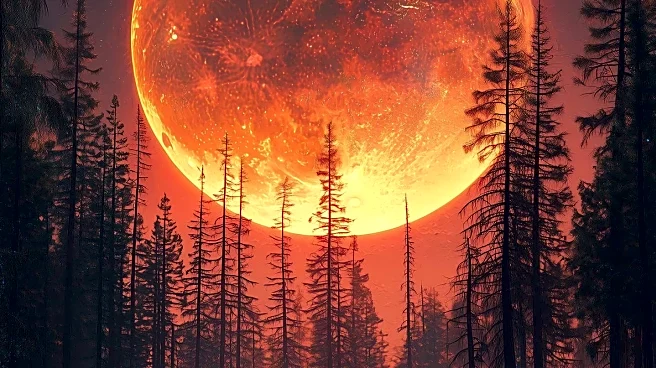Rapid Read • 8 min read
The August full moon, known as the 'Sturgeon Moon,' captivated skywatchers worldwide as it rose on August 9, 2025. This celestial event occurred just days before the peak of the Perseid meteor shower, adding to the spectacle. The Sturgeon Moon is named after the large lake fish that were abundant during this time of year, serving as a vital food source for Native American tribes. It is also referred to as the 'Red Moon' due to its reddish hue in the summer haze. Astrophotographers across the globe captured stunning images of the moon, showcasing its dramatic yellow-orange glow during moonrise and its detailed surface as it tracked through the sky. Notable photographs included the moon rising over iconic landmarks such as New York's Empire State Building, the Colosseum in Rome, and the Eiffel Tower in Paris.
AD
The Sturgeon Moon's appearance highlights the cultural and scientific significance of lunar events. For many Native American tribes, the moon's name reflects historical ties to seasonal changes and food sources. Astrophotographers and skywatchers benefit from such events, as they provide opportunities to capture and study the moon's features. The widespread interest in the Sturgeon Moon underscores the public's fascination with astronomy and celestial phenomena, fostering a greater appreciation for science and nature. Additionally, these events can boost tourism and local economies as people travel to optimal viewing locations.
Following the Sturgeon Moon, skywatchers can anticipate a total lunar eclipse on September 7-8, 2025. This eclipse will transform the moon into a 'blood moon,' visible in Asia, Australia, Europe, and Africa. Such events continue to engage the public and scientific communities, offering further opportunities for observation and study. As interest in astronomy grows, educational institutions and observatories may see increased participation in related programs and events.
The fascination with lunar events like the Sturgeon Moon reflects broader cultural and scientific interests. These events can inspire educational initiatives, encouraging young people to pursue careers in science and technology. Additionally, they highlight the interconnectedness of global communities, as people from diverse backgrounds share in the experience of observing the same celestial phenomena. The Sturgeon Moon also serves as a reminder of the importance of preserving cultural heritage and understanding the historical significance of natural events.
AD
More Stories You Might Enjoy












